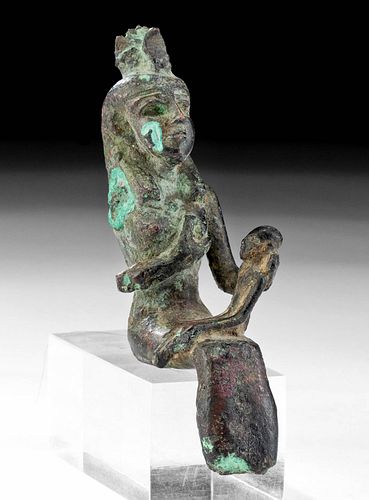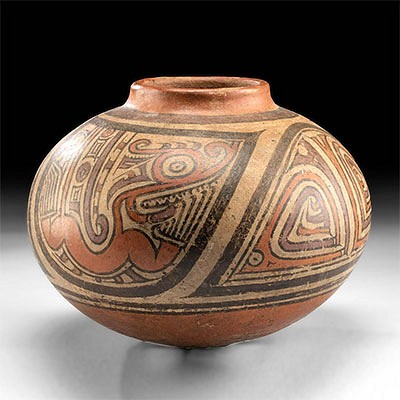Egyptian Late Dynastic Bronze Isis and Horus
Lot 2
About Seller
Artemis Fine Arts
686 S Taylor Ave, Ste 106
Louisville, CO 80027
United States
Selling antiquities, ancient and ethnographic art online since 1993, Artemis Gallery specializes in Classical Antiquities (Egyptian, Greek, Roman, Near Eastern), Asian, Pre-Columbian, African / Tribal / Oceanographic art. Our extensive inventory includes pottery, stone, metal, wood, glass and textil...Read more
Estimate:
$1,400 - $2,000
Absentee vs Live bid
Two ways to bid:
- Leave a max absentee bid and the platform will bid on your behalf up to your maximum bid during the live auction.
- Bid live during the auction and your bids will be submitted real-time to the auctioneer.
Bid Increments
| Price | Bid Increment |
|---|---|
| $0 | $25 |
| $300 | $50 |
| $1,000 | $100 |
| $2,000 | $250 |
| $5,000 | $500 |
| $10,000 | $1,000 |
| $20,000 | $2,500 |
| $50,000 | $5,000 |
| $100,000 | $10,000 |
| $200,000 | $20,000 |
About Auction
By Artemis Fine Arts
Apr 15, 2021
Set Reminder
2021-04-15 10:00:00
2021-04-15 10:00:00
America/New_York
Bidsquare
Bidsquare : VARIETY SALE | Ancient & Ethnographic Art
https://www.bidsquare.com/auctions/artemis-gallery/variety-sale-ancient-ethnographic-art-6811
Featuring classical antiquities, ancient and ethnographic art from cultures encompassing the globe. Egyptian, Greek, Roman, Etruscan, Near Eastern, Asian, Pre-Columbian, Native American, African / Tribal, Oceanic, Spanish Colonial, Russian, Fossils, Fine Art, more! Artemis Fine Arts info@artemisgallery.com
Featuring classical antiquities, ancient and ethnographic art from cultures encompassing the globe. Egyptian, Greek, Roman, Etruscan, Near Eastern, Asian, Pre-Columbian, Native American, African / Tribal, Oceanic, Spanish Colonial, Russian, Fossils, Fine Art, more! Artemis Fine Arts info@artemisgallery.com
- Lot Description
Egypt, Late Dynastic to Ptolemaic period, ca. 664 to 30 BCE. A remarkable cast-bronze sculpture of the goddess Isis seated with her right hand held to her bare breast, ready to suckle the infant Horus (also called Harpokrates) seated in her lap, whom she supports with her left hand in a maternal manner. She wears an ankle-length sheath over her lower body that accentuates the contours of her form and a headdress with an uraeus atop a tripartite wig. Her sweet visage displays a petite mouth, full cheeks, a naturalistic nose, and deep, sunken eyes that were perhaps previously inlaid with fine jewels, beneath a high, arched brow. Horus is shown nude with arms at his sides and a minimalist visage adorned by his incredibly long sidelock of youth, indicating his divine and royal status. A cult figure from this time period, Isis is often shown as a mother goddess as we see here. Covered in brilliant layers of green, aqua, and even violet patina, this is a touching portrayal, probably intended for a niche in a temple or a grave. Size: 1.25" W x 4.75" H (3.2 cm x 12.1 cm)
During the Ptolemaic period, Isis/Hathor, Serapis, and Horus/Harpocrates formed the Triad of Alexandria, a cult for worshipping the three deities that combined Greek and Roman gods with Egyptian ones. Ptolemy introduced this worship as a way to unify the cultures under his rule. Isis/Hathor was associated with childbirth and fertility and Horus/Harpocrates was the god of silence, secrets, and confidentiality.
Provenance: ex-private northern Colorado, USA collection, acquired through descent 2006
All items legal to buy/sell under U.S. Statute covering cultural patrimony Code 2600, CHAPTER 14, and are guaranteed to be as described or your money back.
A Certificate of Authenticity will accompany all winning bids.
We ship worldwide and handle all shipping in-house for your convenience.
#100330Collection number written on posterior of Isis. Missing Isis's right arm from shoulder to elbow, feet, and headdress, as well as Horus's feet. Scratch to cheek. Expected abrasions, commensurate with age. Otherwise, very nice with gorgeous seafoam green patina.Condition
- Shipping Info
-
All shipping is handled in-house for your convenience. Your invoice from Artemis Gallery will include shipping calculation instructions. If in doubt, please inquire BEFORE bidding for estimated shipping costs for individual items.
-
- Buyer's Premium



 EUR
EUR CAD
CAD AUD
AUD GBP
GBP MXN
MXN HKD
HKD CNY
CNY MYR
MYR SEK
SEK SGD
SGD CHF
CHF THB
THB













